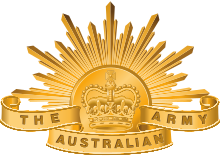
The Australian Army is the principal land warfare force of Australia, a part of the Australian Defence Force (ADF) along with the Royal Australian Navy and the Royal Australian Air Force. The Army is commanded by the Chief of Army (CA), who is subordinate to the Chief of the Defence Force (CDF) who commands the ADF. The CA is also directly responsible to the Minister for Defence, with the Department of Defence administering the ADF and the Army.

In heraldry, a compartment is a design placed under the shield, usually rocks, a grassy mount, or some sort of other landscape upon which the supporters are depicted as standing. Care must be taken to distinguish true compartments from items upon which supporters are merely resting one or more feet, or, sometimes, mere heraldic badges or pure decoration under the shield, and, conversely, care must also be taken in very unusual cases such as the coat of arms of Belize and Gabon, in which what may be taken to be a crest, trees in both coats of arms rising above the shield, is really part of the compartment. It is sometimes said to represent the land held by the bearer. As an official part of the blazon it is a comparatively late feature of heraldry, often derived from the need to have different supporters for different families or entities, although sometimes the compartment is treated in the blazon separately from the supporters.

The coat of arms of the Philippines features the eight-rayed sun of the Philippines with each ray representing the eight provinces which were placed under martial law by Governor-General Ramón Blanco Sr. during the Philippine Revolution, and the three five-pointed stars representing the three major island groups of Luzon, the Visayas, and Mindanao.

The First Australian Imperial Force was the main expeditionary force of the Australian Army during the First World War. It was formed as the Australian Imperial Force (AIF) following Britain's declaration of war on Germany on 15 August 1914, with an initial strength of one infantry division and one light horse brigade. The infantry division subsequently fought at Gallipoli between April and December 1915, with a newly raised second division, as well as three light horse brigades, reinforcing the committed units.

Honi soit qui mal y pense is a maxim in the Anglo-Norman language, a dialect of Old Norman French spoken by the medieval ruling class in England, meaning "shamed be whoever thinks ill of it", usually translated as "shame on anyone who thinks evil of it". It is the motto of the British chivalric Order of the Garter, the highest of all British knighthoods, except in Scotland.

The coat of arms of Australia, officially the Commonwealth Coat of Arms, is a formal symbol of the Commonwealth of Australia. It depicts a shield, containing symbols of Australia's six states, and is held up by native Australian animals, the kangaroo and the emu. The seven-pointed Commonwealth Star surmounting the crest also represents the states and territories, while golden wattle, the national floral emblem, appears below the shield.

A slouch hat is a wide-brimmed felt or cloth hat most commonly worn as part of a military uniform, often, although not always, with a chinstrap. It has been worn by military personnel from many different nations including Australia, Ireland, the United Kingdom, Canada, India, New Zealand, Southern Rhodesia, France, the United States, the Confederate States, Germany and many others. Australia and New Zealand have had various models of slouch hat as standard issue headwear since the late Victorian period.
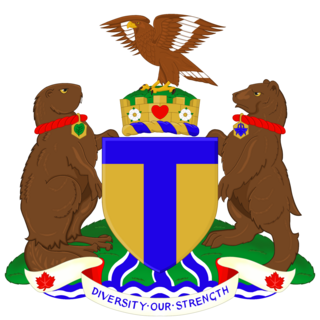
The coat of arms of Toronto is a heraldic symbol used to represent the city Toronto. Designed by Robert Watt, the Chief Herald of Canada at the time, for the City of Toronto after its amalgamation in 1998. The arms were granted by the Canadian Heraldic Authority on 11 January 1999.
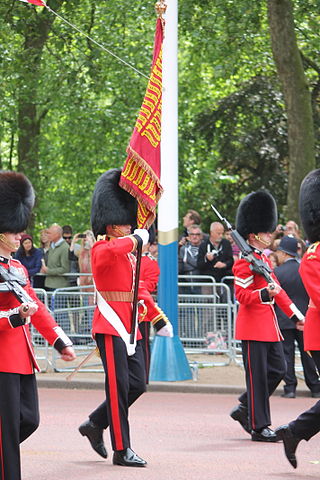
In military organizations, the practice of carrying colours, standards, flags, or guidons, both to act as a rallying point for troops and to mark the location of the commander, is thought to have originated in Ancient Egypt some 5,000 years ago. The Roman Empire also made battle standards reading SPQR a part of their vast armies. It was formalized in the armies of Europe in the High Middle Ages, with standards being emblazoned with the commander's coat of arms.
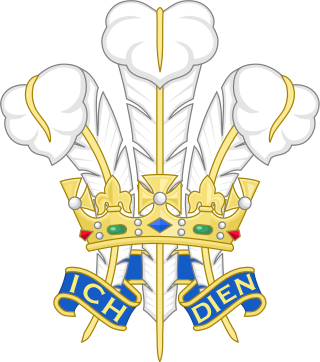
The Prince of Wales's feathers are the heraldic badge of the Prince of Wales, the heir to the British throne. The badge consists of three white ostrich feathers encircled by a gold coronet. A ribbon below the coronet bears the German motto Ich dien. As well as being used in royal heraldry, the feathers are sometimes used to symbolise Wales itself, particularly in Welsh rugby union and Welsh regiments of the British Army.
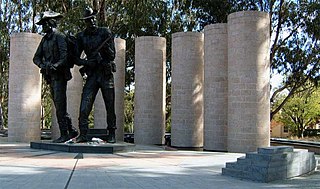
The Australian Army Memorial on Anzac Parade commemorates the service of Australian soldiers.
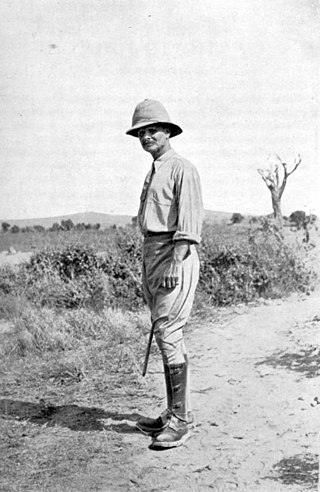
Field marshal is the highest rank of the Australian Army and was created as a direct equivalent of the British military rank of field marshal. It is a five-star rank, equivalent to the ranks in the other armed services of Admiral of the Fleet in the Royal Australian Navy, and Marshal of the Royal Australian Air Force. The subordinate army rank is general.

The flag of the governor general of Canada is a flag used as a symbol to mark the presence of the governor general of Canada. Such a flag has been used by governors general since just after Canadian Confederation and the design has altered over decades. The current flag was adopted in 1981.

A Royal Badge for Wales was approved in May 2008. It is based on the arms borne by the thirteenth-century Welsh prince Llywelyn the Great, with the addition of St Edward's Crown atop a continuous scroll which, together with a wreath consisting of the plant emblems of the four countries of the United Kingdom, surrounds the shield. The motto which appears on the scroll, PLEIDIOL WYF I'M GWLAD, is taken from the National Anthem of Wales and is also found on the Welsh designs for £1 coins minted from 1985 until 2000. The badge formerly appeared on the covers of Assembly Measures; since the 2011 referendum, it now appears on the cover of Acts passed by the Senedd and its escutcheon, ribbon and motto are depicted on the Welsh Seal.

Unit colour patches are a method of identification used by the Australian Army, used to indicate which unit a soldier belongs to.

The coat of arms of Calgary was adopted in 1902. The arms existed only in black and white until 1984, when an alderman asked the city to develop it in full colour.

Naval heraldry is a form of identification used by naval vessels from the end of the 19th century onwards, after distinguishing features such as figureheads and gilding were discouraged or banned by several navies.

The Tudor Crown, also known as the Imperial Crown, is a widely used symbol in the heraldry of the United Kingdom. In use officially from 1902 to 1953 and again from 2022, it represents both the British monarch personally and "the Crown", meaning the sovereign source of governmental authority. As such, it appears on numerous official emblems in the United Kingdom, British Empire and Commonwealth.

Oxley War Memorial is a heritage-listed memorial at 1218 Oxley Road, Oxley, Queensland, Australia. It was built in 1920. It is also known as Oxley Memorial Park and Oxley Place. It was added to the Queensland Heritage Register on 4 July 2006.
The uniforms of the Australian Army have changed significantly over the past century, although the accoutrements worn over this period have remained relatively similar. The forces of the Australian colonies and the early forces of the Commonwealth post-Federation in 1901 closely followed the uniforms of the British Army. Since then it has continued to be influenced by British but also US styles, as well as including some distinctly Australian designs, reflecting local conditions and trends.
